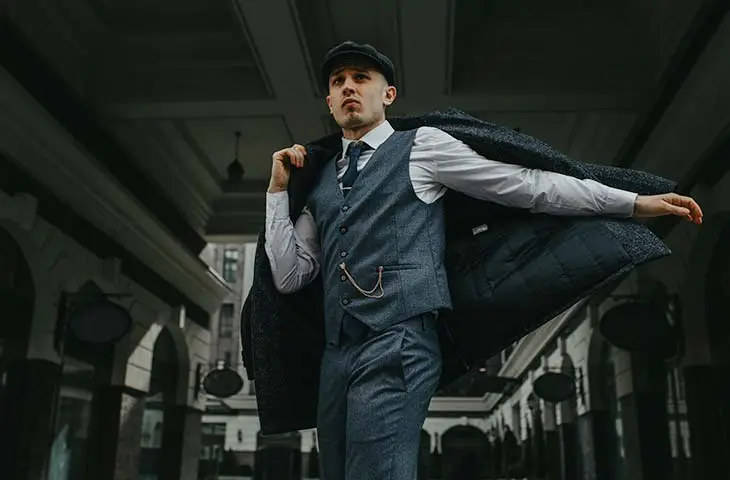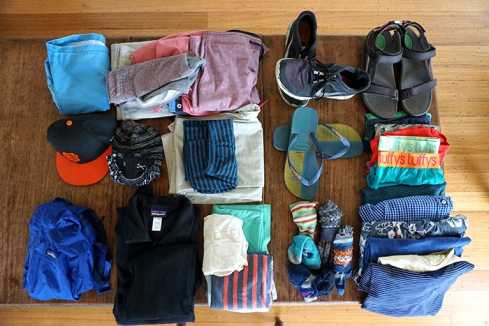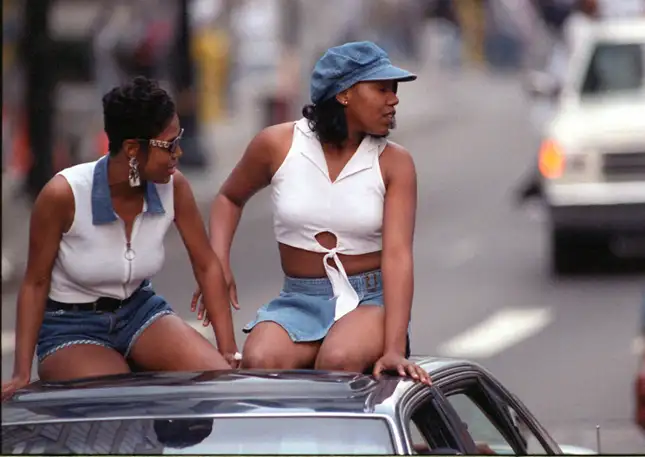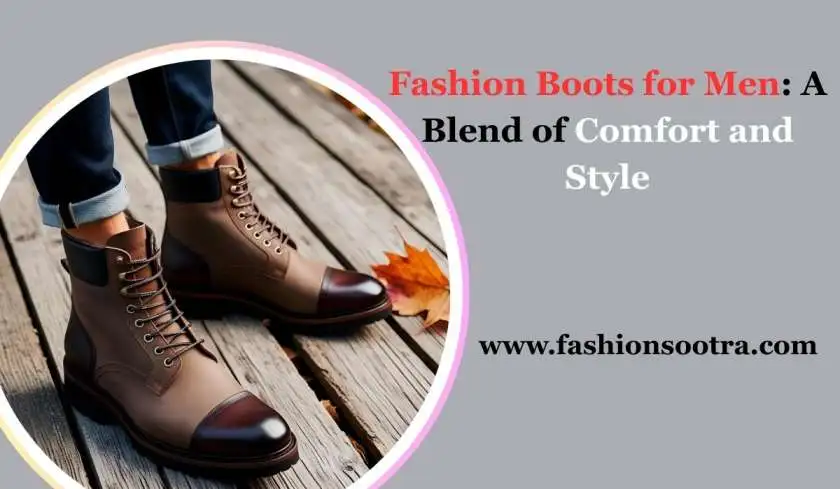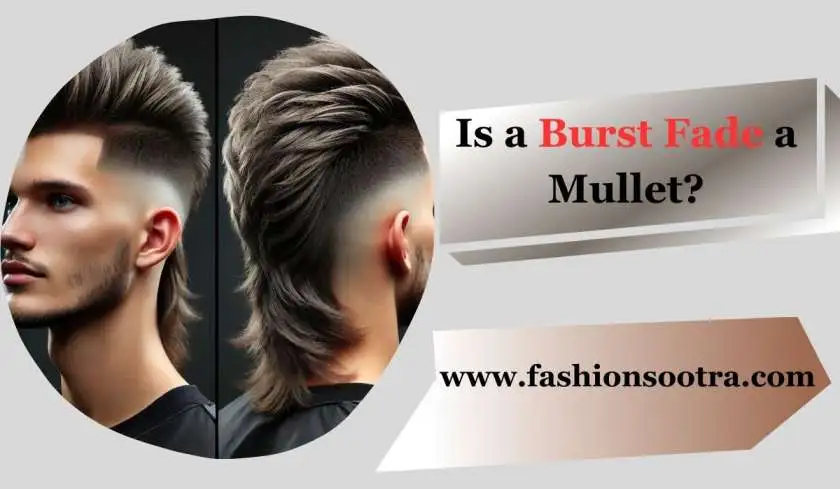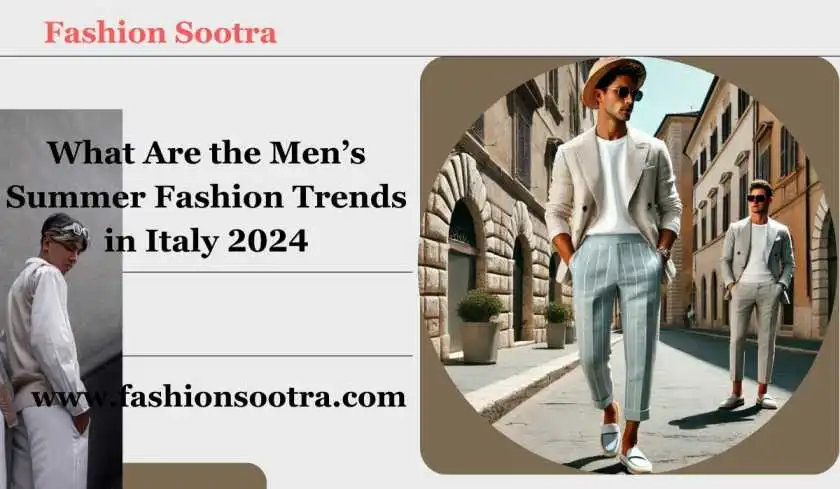Any conversation about men's fashion in the 1920s must first include some cultural background. In the United States, the Roaring 20s brought about tremendous political, economic, and social transformation. Society began to quicken as World War I ended in 1918. People acquired fresh liberties and money for home goods, amusement, and Roaring 20s Fashion Men.
Along with the beginning of the Prohibition era and the growth of speakeasies, nightclubs, and infamous gangsters like Al Capone, 1920 also brought All things considered, fashion as much as society underwent marked change from earlier decades. Many of the classic and timeless designs of the Roaring 20s helped define the people living today.
How did men's style evolve throughout the 1920s?
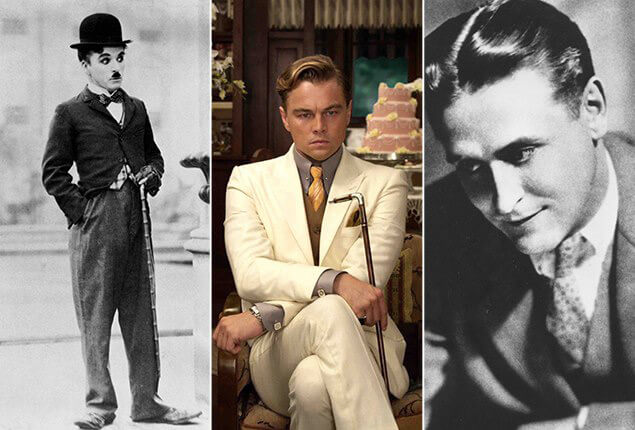
For the working class as well as the wealthy, the Roaring 20s were a period of affluence, entertainment, and personal freedom. It also heralded the beginning of consumerism. Men's and women's fashions began stressing these developments since fashion represents the era.
Read Also: Frugal Male Fashion: The Art Of Male Style
Working class people in the 1910s wore robust, long-lasting clothing made of durable materials. Too, most folks went for the neat appearance.
But by the beginning of the 1920s, designs had grown more laid back than they had ever been. More companies produced clothing using softer materials and somewhat looser fits. Though it was still utilitarian, formal clothing grew increasingly varied, sophisticated, and glittering.
- What Does A Guy Wear To Prom: Prom Outfits For Men
- 1920s Men's Fashion Trends: What You Need To Know?
Rich ladies choose flapper dresses, cocktail dresses, and shorter skirts—the latter of which initially gained popularity in European fashion. Elite men continued to wear custom suits as previously, but there were some obvious alterations.
First of all, the emergence of gangsters shaped most of the fashion of males in the 1920s. This includes the infamous Birmingham, England street gang Peaky Blinders, who popularised several classic designs like three-piece suits and flat hats.
Gone were the shoulder padding and rigid fit of the past decade. These were replaced by tailored suits with cuffed pants folded in the front for a stronger profile and form-fitting suit jackets with softly sloping shoulders.
Additionally popular in the 1920s were casual attire. Sportswear and leisure clothing debuted as menswear become less regulated.
This meant sweaters, plus-fours, and other wide or baggy pants, workplace pants, jumpers, hats, and a rainbow of accessories people could wear to express themselves. Particularly sports apparel had to be stylish enough and still useful for the middle and upper classes to wear.
Suit coats and matching ties were still in style for the young, educated guy, but they lacked constriction. Men's wear from the more laid-back 1920s also included cardigans, knit pullovers, and ankle socks. Men also started sporting bow ties and a wider range of headgear, including fedoras, and changed over to button-down shirts with removable collars.
Regarding textiles, the 1920s deviated somewhat from the decade before. Though synthetic fabrics like rayon also grew more widespread, clothes were still fashioned from natural fibers such cotton, wool, linen, and silk. Simultaneously, softer textures, wider diversity of knits, and new textile manufacturing processes with more medium-weight as opposed to heavy-weight clothing emerged.
Many believe the Roaring 20s marked the beginning of the seasonal fashion cycle of today. People no longer had to spend years on end dressing alike. Rather, there was more diversity in forms, colors, patterns, and designs than in past times. This allowed them to modify their approach as necessary to follow the newest vogue.
Fallacies regarding the dress of men in the 1920s
If you have ever read Fitzgerald's The Great Gatsby Roaring 20s Mens Fashion you most certainly know the Roaring 20s as a wild, dazzling, carefree period. Ultimately, the 1920s were a time of postwar hope and increased freedom for which there much to celebrate.
Menswear has begun to migrate in the United States from the classic khaki and neutral tones of browns and greens to more striking colors and unique designs. This meant lighter colors, more vibrant shirts, brighter suits, more casual wear choices.
Not everyone, meantime, donned cocktail dresses and looser suits or spent all their leisure time at speakeasies. Neither did everyone have the money for such items.
Styles from all across the world—especially Europe—were sailing across the seas during the Roaring 20s. Though casual wear became popular, formal wear remained somewhat trendy.
Men's formal evening attire, for instance, usually consisted in a top hat, tuxedo, and leather oxford shoes. Men would often dress in navy blue, gray, or brown in formal and semi-formal settings using tweed, herringbone, or pinstripe suits. Particularly older gents still favored the traditional top hat above the fedora or Derby helmet.
Along with this, one of the most common misunderstandings regarding the Roaring 20s fashion is that it was all about glitz and style. Actually, even if it was certainly varied, it was nevertheless very sophisticated and pragmatic.
See Downton Abbey for a more realistic portrayal of men's formalwear at this period. At the period, several features like the hat styles and thin, tapered pants also were somewhat common in the United States.
Men'swear in the 1920s
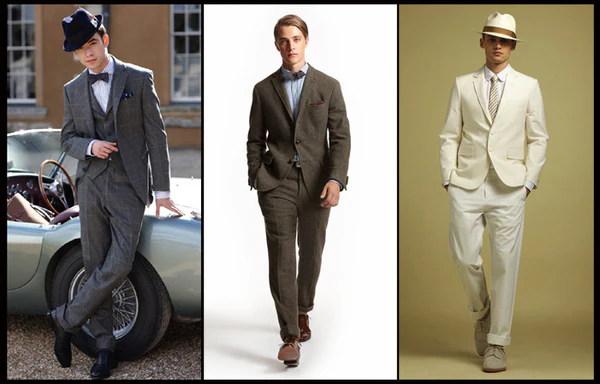
Here are some suggestions if you want to copy the iconic, ageless roaring 20s fashion men dress styles from the United States.
Appropriates
Men's outfits from the 1920s resembled those found now rather closely. Their thinner fit and simpler style at the beginning of the decade reflected their By the end of the decade, they would have grown more vibrant and looser.
For formal dinners and nighttime gatherings, many men still favored the classic tuxedo or three-piece suits. Inspired by the criminals of the day, suits sometimes included black and white pinstripes or tiny patterns. Popular hues were blue, gray, brown, and white.
Still, suits also followed more striking designs such plaid, herringbone, and broad stripes. Early in the 1920s, guys seeking a long, lean figure also started to like jazz suits.
Though there were single-breasted choices, most three-piece suits were double-breasted. The suit jacket featured broad pointed lapels to accentuate the waist and shoulders and was higher waisted than it had been. It also included a three- or four-button closing down the front. Flat in the front, suit pants featured smaller waistlines and tapered legs.
Style evolved with age and season. For summer, for instance, barbershop singers and college students sometimes chose a striped or blue blazer with white slacks instead of a whole suit.
Regarding cloth, wool, flannel, linen, tweed, and combinations were still very popular.
Pajamas
Men's button-down shirts usually featured plain colors, including pastel, or highlighted opposing vertical stripes. These shirts also had a rounded collar that let the user flaunt their tie and removable for simple washing. Sometimes sophisticated guys would additionally pin the collar.
Most shirts of the late 20s featured matched collars either plain or striped. Certain casual shirts arrived in neutral and pastel tones like lilac or sky blue and lacked a collar at all. Plaid and candy stripe shirts also started to popular about this period.
Younger guys sometimes wore shirts made from softer materials like cotton. More informal wear with a turndown collar, single cuff or cufflinks, or single barrel cuffs with a button was not unusual. Shirts might include either partial or complete button downs.
Men would occasionally wear Peaky Blinders shirts, popularly known as penny collar shirts, to the club or in mild weather. Made-to- measure and complemented the wearer's form, these were
Read Also: How To Dress A Muscular Male Body
Men would roll up their sleeves on hot days as short-sleeve shirts were not very prevalent in the Roaring 20s Fashion Men. Apart from the removable stiff collar, the general fit is still regarded as rather contemporary.
Suits
Most guys wore cotton or wool pants. Usually snug at the waist, they nonetheless expanded more than they had previously. Pants were neither particularly long or slender; their legs usually were straight or cuffed. Higher and fastened with button suspeners or a belt, the waistline was Because it offered pants a lovely crease that stayed even when the wearer sat down or walked, the single pleat gained popularity in the United States at this period.
Oxford bags arrived in North America about toward the end of the 1920s. Particularly well-liked among college students and younger men, these trousers were looser than typical choices and wide-leg for a comfortable fit.
Although low rise pants had not yet taken the stage in the nation, fashion-forward people could still enjoy plenty of interesting designs and hues. This included herringbone, plaid, stripe, check, and tweed. Popular hues were gray, white, black, beige, and khaki.
Waestcoats and Vests
Unlike in the 1910s, the Roaring 20s Fashion Men clothing did not demand vests and waistcoats. Still quite conspicuous, though, they had a smaller cut. Usually buttoned up high, they lacked lapels at the end of the decade or had notch lapels.
Vests and waistcoats most fit slender people. To highlight the shirt and tie under, they also featured longer, pointed points and a deeper front than previously.
Though some educated gents still favored double breasted ones, Vests featured pockets in the front were usually single breasted. Working class people would often mix a good vest with matching pants as they cannot always afford a three-piece suit.
Often featuring geometric or colorful designs, these solid-colored clothes ranged in black, blue, or gray. Some were tweed or knitted. Men seeking a more laid-back or athletic look would sometimes pair a pullover knit vest over a shirt.
Upperwear
Suits and pants matched outerwear like coats and overcoats. For instance, the coat was fitting at the waist just like the suit was fitting there. The outerwear would also fit similarly if the suit or pants were looser and broader.
Men's jackets sometimes stretched below the knee and had large lapels and broad shoulders. Others were fitting at the top and roomier at the waist and hips to accentuate any form. Though outerwear could be almost any shape and design, one very popular choice was the straight hanging coat, which did not tighten at the waist.
Generally speaking, outwear was less vibrant than shirts or jeans. They started off in neutral tones like brown or black. Darker tones, such navy blue, however, gained popularity when the British fashion arrived in the United States since they looked well almost everywhere. These hues also more matched those worn by the Peaky Blinders group in terms of look.
Formal outwear might be either double or single breasted. More opulent clothing used a basic silk lining instead of the once-popular thick fur lining seen in tweed and wool jackets.
Generally speaking, outerwear fit closer to the body and was on the heavier side than most contemporary clothing. Wool jackets finished coarsely and were rather robust. People choose silk-lined coats with cotton or linen sleeves in warmer months as they were lighter and less stiff. Sometimes these coats featured a largely square cutaway front.
Shoes for Men in the 1920s
The Oxford shoe swept the United States during the Great Gatsby era as a more comfortable substitute for other formal choices. Other often used choices were wingtip shoes, patent leather shoes, two-tone athletic shoes, high-cut work boots, and winter boots.
Materials-wise, most men's shoes were built of a combination of canvas and leather. Still, some shoemakers began to include lizard skin into their creations. Whatever the material, most shoes came in varying tones of brown, black, or white.
Men's Accessory Styles in the 1920s
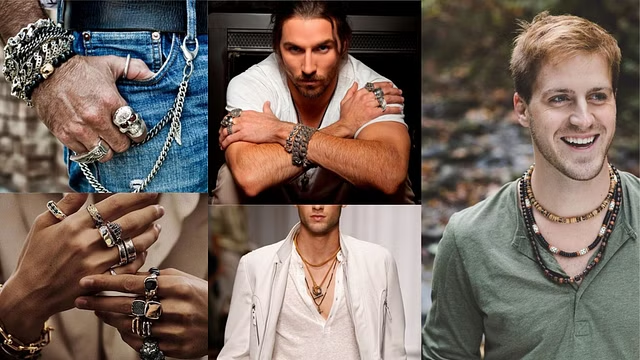
Caps
The 1920s had no lack of headwear. On formal events, guys would often dress in top hats along with a tuxedo. Usually fashioned from Buckham, these top hats were robust. Some were rigid; others were foldable.
A more laid-back substitute for top hats, middle-class men would often wear fedoras and bowler (or Derby) caps. For winter, these were black; for summer, they were bright. Fedoras also featured a downward front and rear and a broad brim. Older guys might turn one side of the brim upward and keep another side down; the younger set usually rolled the sides upward.
Another laid-back choice was the boater or skimmer cap. Best for outdoor use, these rigid caps were often constructed from thick straw and worn throughout summer. Most fell between tan and light brown.
Other choices included several flat hat designs including the newsboy and ivy caps and tweed hats, which were also worn for sports such golf. Usually floppy as they lacked a firm brim, newsboy and related sports hats were They came in lesser hues and were built from wool or cotton as well. A few even had a checkered or plaid design.
Hats got more unusual and brighter hues at the end of the 1920s. Bowler caps could, for instance, be blue or green. The hat was supposed to accentuate the clothing regardless of color or design.
Wallet Squares
Many times, pocket squares were created from silk or linen. By providing a burst of color, they were supposed to improve the wearer's outfit and complement the whole appearance.
Richer, older men were unusual sight without a pocket square. While some choose stronger or art deco graphics, others would go for plain colors. Apart from anything else, the pocket square would complement the tie, hat band, or shirt color.
watches
Though pocket watches still dominated Roaring 20s Fashion Men, firms like Elgin National Watch Company and Rolex entered the picture. Along with creating the first waterproof timepiece comprised of precious metals, a screw-down crown, and a case back, Rolex started designing luxury wristwatches for the elite. Concurrently, Elgin National Watch Company produced clocks suitable for the typical working man.
In the 1920s, Cartier Tank also began manufacturing wristwatches, which gained popularity among cinema stars such Rudolph Valentino and Clark Gable for use in their films.
Optical glasses
Wearing spectacles in the 1920s was seen as trendy. Pince-nez, rimless spectacles worn on the nasal bridge were a popular fashion. These came with a string that would hang down one side and fastener to the wearer's clothing. Older, refined gentlemen like President Theodore Roosevelt wore them, especially ones built with a gold or wire frame.
Also quite common were round glasses, which finally helped to define oval and octagonal forms. Eyewear companies began creating bigger frames in a variety of hues including dark brown, black, or tortoiseshell for a sportier appearance. Though there were lighter choices, too, rimmed spectacles tended to be hefty.
Still, eyewear was about more than simply appearance. Made specifically to lessen sun glare and guard the wearer's eyes, special lenses
Neckwear and Ties
Around the 1920s, neckties were quite trendy. More importantly, the choices now included solid hues like purple, pink, and gray, plaids, and horizontal stripes. Additionally changing to provide the wearer more freedom of expression were bow ties. In addition, United States menswear debuted European trends of diamond patterns and paisley designs.
Generally speaking, depending on the season and event, neckties were fashioned from fine silk or knit wool. Originally made from silk or rayon, scarf ties—which were fastened under the sweater and fashioned in a Windsor knot—were also very popular.
Collar pins and clips were another approach many men used to vary the appearance of their neckwear. Still, neckwear did not truly start to vary until perhaps the late 1930s or early 1940s.
Men's Formal Wear in the 1920s
Most men in the Roaring 20s wore either a black or dark navy suit or tuxedo whether they were getting married, having a sophisticated dinner party, or attending a ball. Still very much in use for formal gatherings, the tuxedo tailcoat was a fitting jacket with a tail at the rear. Longer than in past decades, formal three-piece suits were also somewhat less structured to let for greater flexibility and comfort.
Usually, sophisticated guys coupled their suit or tux with a classy top hat to complement their look. Sometimes they would also include a well folded pocket square and a nice watch in their suit pocket. For formal and special events, white ties were very common; black ties also began to be rather popular.
Men might occasionally pick a dinner jacket rather than a three-piece suit for somewhat less formal parties; ladies may wear a cocktail dress. In addition, the formal day attire that had been fashionable in the past became reserved for big events. Its appearance shifted to show less buttons and higher-waisted trousers.
Additionally formed in the 1920s were several premium clothing companies including Gucci. Specifically Gucci started creating and manufacturing a higher class haute couture style. These clothes fit the refined, intelligent man exactly.
Men's casual dress in the 1920s
Men began to dress more in casual clothes, particularly on cooler days, wearing sweaters notably. Thanks to the impact of sports and leisure clothing, informal attire typically included plus-fours and knickersbocks—even for individuals who did not play sports.
Usually unbuttoned, casual shirts have striped or brighter designs. As with the henley shirt, younger people began sporting softer, attached collars or opting for collarless clothing.
University of Oxford students began sporting Oxford bags, which were far wider and far baggier than most men's pants. Thanks to Levi Strauss & Co.'s popularizing of denim, younger men also began to migrate to jeans.
Older men were still essentially swayed by Edwardian era (1901 to 1910) trousers most of the time. Their casual pants were somewhat thin, high-waisted, straight-leg, tapered at the bottoms.
Men's Personal Care in the 1920s
Men's grooming habits changed a bit throughout the Roaring 20s Fashion Men. Sideburns were chopped higher than they had been, for starters. For still another, hair was kept medium length.
Trendy looks at the period included the comb-over, a single part in the hair, or a completely slicked back appearance. This was true whether the man wore a hat or not; however males in college started straying somewhat from these appearances.
Many times, guys would utilize certain oil products to maintain their hair in place all day. Those with straight hair found several of these styles simpler. Men like Charlie Chaplin had wavier hair and, although they would still observe grooming standards, they tended to have a wilder or slightly mussed-up look.
Regarding facial hair, ideas have evolved in the 1920s. Having any sort of facial hair—but particularly a beard—was sometimes considered as dirty. Older men might occasionally, however, get away with a well-groomed, precisely cut mustache as it made them appear older, wiser, and wealthier.
Men's Fashion icons of the 1920s
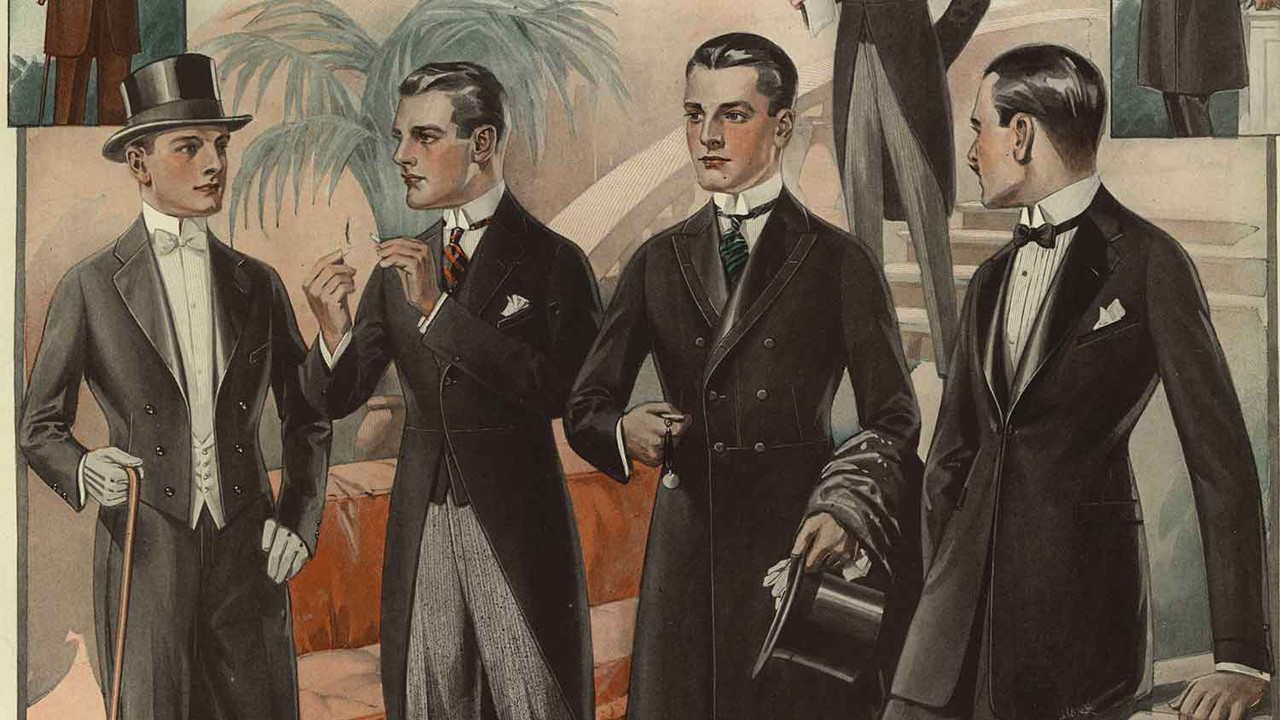
Men's fashion icons developed in the 1920s and included:
Douglas Fairbanks
Considered both Hollywood royalty and a "all-American" guy, Fairbanks was a great movie star. He created the current action hero. Tom Ford's slim-fit bib front cotton shirt, a checkered wool suit jacket, fitted slacks, and ribbed silk tie became his most recognizable look.
Rudolph Valentine
Valentino, a great actor in The Sheik, embodied masculinity in the 1920s most precisely. He tended to have a refined appearance and developed the slicked-back haircut known as the "Vaselino."
Al CapONE
Apart from being among the most infamous gangsters of all time, Al Capone has a really unique manner. He would frequently dress in dark or lime-colored three-piece suits, premium brown or black oxfords, some with wingtips, and a custom jacket with patch pockets. He also flaunted a white pocket square, a sophisticated fedora or boater hat, buttoned barrel cuffs, and lots of jewelry.
F.; Scott Fitzgerald
Renowned writer Fitzgerald was famed for both his book, The Great Gatsby, and for capturing the Jazz Age flamboyance. Often sporting a contrasting pocket square, he donned elegant, plaid or flannel suits with large notched lapels, ties of varying lengths, patterns, and forms.
Humphrey Bogarts
Although Bogart was a well-known American actor in theater and movies, especially in crime dramas, he also helped double breasted suits become fashionable. He usually wore a hat, trench coat, neat, smart suits, varying ties and bowties.
Frederick Astaire
Considered as one of the finest dancers in all of cinema history, Fred Astaire had a distinctive approach combining silk handkerchiefs as belts, custom fitted suits in subdued hues, and wide coats with still-perfect form. He wasn't worried about messing things about, though, as he also frequently wore vibrant clothing and striking designs that always managed to seem elegant.
Garry Grant
Popular icon Cary Grant, a British-American actor, frequently wore a more laid-back outfit with fitted jeans, clean white shirts, and different knitwear. He avoided headgear since he thought they looked ugly on his facial type.
Cooper Gary
Leading man in several Hollywood films, Cooper was renowned for his modest acting approach and timeless style. Although he wore loose jackets and wide, fitting slacks, he was equally right at home in three-piece suits.
Where to get men's clothes from the 1920s?
Many outlets, including Amazon, Etsy, eBay, and many specialist retailers, provide 1920s themed menswear.
Many men's luxury businesses nowadays also create clothing suited for the Roaring 20s era from design and fabrication. This covers labels like Tom Ford and Gucci, however much of what you will discover on their website fits the present day. Having said that, you should be able to locate anything for accessories like pocket squares or clocks.
If you are searching for something particular, though, your best choice is to visit a made-to- measure or ready-to- wear store. These stores stress excellence and customize every item to the taste of the wearer. Furthermore, as the clothing are custom-made, you might find unusual materials, colors, and designs.
Men's fashion bottom line in the 1920s
For excellent reasons, the 1920s were also referred to as the Jazz Age or the Roaring 20s Men Fashion. For many Americans, they were a period of freedom, change, and wealth. Men and women have more chances to express themselves via fashion in addition to greater discretionary cash right at their hands.
Men's fashion in the 1920s drew mostly on European influences and the emergence of gangsters like the Peaky Blinders. Although many males still wore elegant, fitted suits, the decade saw a shift in dress from leisure day clothing to sportswear.
This meant more patterns, stronger colors, and unusual cuts than in years before. It also caused improvements in textiles; many clothing grew softer, more comfortable, and more roomy than the stiff, coarse structure employed before.
Among the items still heavier than what you would find now were suits, overcoats, slacks, and jackets. Still, many of the contemporary fashion trends now in use are derived from ones that gained appeal in the United States a century ago. For instance, the pinstripe suit and silk-lined jackets began to emerge in the Roaring 20s Men Fashion.
Fitzgerald's The Great Gatsby or Downton Abbey are the only places you should search for extra ideas for 1920s attire. And, look at a made-to- order store or specialist brand online if you want to replicate one of the several 1920s styles now.
FAQs
How to dress for a roaring 20s party for men?
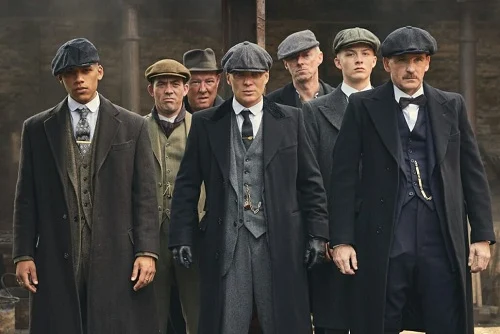
Including a long-sleeved shirt (white, striped or light colored) with removable collar and cuffs, a tie, a suit jacket, a somewhat wide golf pants, high socks and of course shoes (richelieu, Derby, lace-up shoes, occasionally two-tone), it is inevitably a 3-piece suit.
How should I dress in the 1920s style?
Look for sheath dresses with lace or beading across the bodice and skirt for excellent Great Gatsby Roaring 20s Mens Fashion. Long gloves, headbands, and other fantastic accessories will accentuate this outfit as well.
What did poor men wear in the 1920s?
Popular choices were thick, made-to-last materials such tweed, Donegal and herringbone. Often used with a big overcoat in winter, they were warm and hefty. Along with pleated pants, baker boy and flat hats were mainstays. How would one accomplish this now?
What is 1920s style called?
Women'swear. This simplicity produced the iconic tubular "la garçonne" appearance that ruled most of the decade. Often referred to as the flapper, the 1920s dress pattern featured reduced waist and creeping hemlines made possible by reasonably priced materials.
What is the roaring 20s fashion?
Most people's first image of 1920s fashion is that of the flapper style. Cut cut their hair into a short, almost manly fashion, flappers did. They chose flowy, short fitting gowns. Big, elegant straw caps gave way to little caps like cloches, a basic hat fashioned like the bell of a flowerpot.
What makes a 1920s suit?
The fabrics and how they fit define the suits of men from the 1920s from previous decades. Though lighter than in previous decades, suits were generally composed of thick wool, wool tweed, mohair, wool flannel, and corduroy that made them heavier than modern suit materials.
What do guys wear to a Gatsby party?
Men should strive for a classic, elegant appearance reflecting the fashion of the 1920s for a celebration. This covers a custom suit, ideally in a neutral like black, navy, or grey. Another excellent choice is a three-piece outfit including a vest.
Which fabrics became popular for men's clothing in the 20s?
Among the most often used textiles in the Roaring 20s Fashion For Men, also known as fake silk. Among the other often used textiles were silk, cotton, wool, and fur.
Did men wear fedoras in the 1920s?
Rising to the top of men's casual and formal wardrobes, the fedora hat is definitely on its way to occupy the bowler hat throne. Many men changed their emblem of the respectable, contemporary gentleman in the 1920s to the broad brim fedora.

